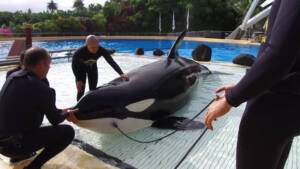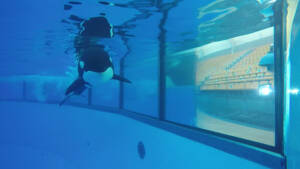A recent study of Loro Parque’s orcas published in The Journal of Acoustical Society of America has perfected the methodology that helps assess the hearing ability of great whales, a technique that is very complex due to the enormous layer of fat that covers their brains. For this purpose, synthetic sound waves have been developed that take into account the anatomical characteristics of the inner ear of the animals, in such a way that at the same time they stimulate all the neurons in charge of detecting the different sound frequencies. This produces a more intense brain response in cetaceans, which is easier to measure through the fat.
This methodology opens the door to the study of the acoustic capacity of the great whales, something that so far has not been possible, and that is critical when it comes to establishing how the growing underwater noise levels are affecting them. The impact of humanity in causing the increasing intensity of noise in the oceans represents a great threat for cetaceans and these types of studies are essential so that countries and international organisms can establish measures of protection and limitation of noise to protect whales.
This study has also served to confirm Morgan’s deafness, which had already been detected by her caregivers and verified by other previous scientific studies. The technique used on this occasion is the most sensitive in existence, so the total absence of Morgan’s brain response to sounds leaves no doubt that this orca, rescued near dead in the Netherlands, has a deafness problem, the cause of which is unknown.
Ever since Morgan’s deafness was first detected, Orca Ocean’s team of caregivers at Loro Parque designed a system based on gestures and lights that they use to communicate with her and that have allowed her total integration into the orca group. Nowadays, Morgan is in perfect welfare conditions in the Park and has even had her first calf, Ula, which will turn one year old this September.













